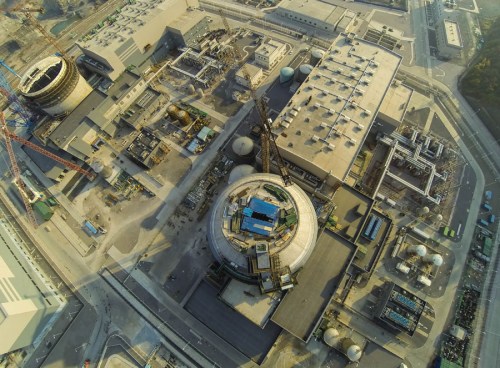
The Sanmen nuclear power plant, which was under construction in Sanmen, Zhejiang Province. (Photo/Xinhua)
China started fuel loading Westinghouse Electric Co's first next-generation nuclear reactor in Sanmen nuclear power plant in Zhejiang province on Wednesday night after getting government approval, China National Nuclear Corp and Westinghouse said in separate statements.
Fuel loading is a major milestone and one of the most important steps for the delayed project. Westinghouse has conducted 55 tests at Sanmen Unit 1 since last summer to ensure operational safety.
Considering the fact that the government has not approved construction of any new, non-demonstration reactors since 2015 and Sanmen Unit 1 is the first of this type of reactor, analysts said the fuel loading is a small step toward the first AP1000 in the world.
"The initial fuel loading at Sanmen Unit 1 is a big milestone as the development learning curve will help with the construction of more units in the future, and could enable them to be built more rapidly and gradually cut development costs," said Joseph Jacobelli, a Hong Kong-based senior analyst of Asian utilities at Bloomberg.
"It is also important for China National Nuclear Corp, which needs new units for earnings growth."
The AP1000 is a so-called generation III+ reactor, designed to be safer and less expensive to install and operate than previous models.
Jacobelli believed there is a good chance that the unit may come online before the end of the year.
"The actual commissioning time, however, may take several months as a lot more testing is required and any slight issue will delay the commissioning," he said.
China plans to start construction of six to eight nuclear reactors this year and raise its total nuclear generating capacity by as much as six gigawatts, the National Energy Administration said in March.
China also aims to complete two long-delayed, foreign-designed third-generation reactor projects this year, including Sanmen Unit 1 and the first unit of the Taishan European Pressurised Reactor project designed by Areva in Guangdong, which was approved for fuel loading by Chinese regulators on April 10.
By 2020, the world's second-largest economy expects to have 58 gigawatts of installed nuclear power, an increase of 16.5 percent year-on-year.
Jacobelli added that the future of Westinghouse, which was purchased by Brookfield Business Partners LP after filing for bankruptcy last year, may depend on its success in Sanmen, which might help trigger orders from other countries.
However, this is a long way off as Chinese authorities are extraordinarily cautious about new technologies, so the AP1000 units will need to run for a while before such a decision is made, he said.
Westinghouse has vowed to continue introducing its AP1000 nuclear reactors in China, Jose Emeterio Gutierrez, president and CEO of the nuclear energy technology provider told China Daily earlier. In the case of China, there is a real opportunity to use nuclear energy to provide clean energy that the country needs to improve air quality and daily life, he said.


















































